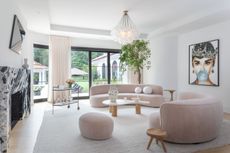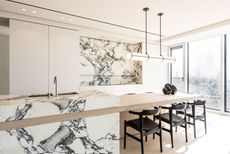What are the best dining room colors? These schemes will make any dinner guest feel at home
When in comes to choosing a scheme for your space, these dining room color ideas are anything but basic
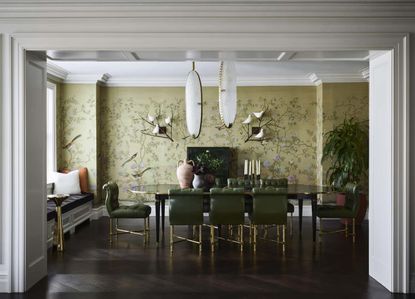

If you're looking to make an impact with your interiors, these fresh dining room color ideas will give this important room the dues it deserves. After all, it's 2024, and a dining space's décor shouldn't be stuck with yesteryear’s formal trappings. Consider giving it a brand new look with a more interesting, potentially more vibrant color palette.
Whether it's paint, wallpapers, upholstery or any other kind of colorful addition to your space, you should find that in today's world, injecting a new and more exciting palette into your dining room isn't all that hard. And as we find out, certain colors can make you feel cozy or happy, some others can awaken your appetite and even spur conversations.
We spoke to interior designers and color experts to find out the colors that best contribute to a dining room's atmosphere. Here's what they suggested.

Aditi is a homes writer and editor with several years of experience. Her articles, backed by expert insights, offer suggestions aimed at helping readers make the best home design choices. For this article, she spoke to top experts to understand the best colors for dining rooms.
8 dining room color ideas for a stylish, relaxing space
1. Beige is a soothing color to live with

No, beige is not boring. Beige is subtle yet has a significant presence. It is nearly infinite in its tones and mood-generating abilities. It looks different depending on the architecture and light. And, is the ideal companion to most other tones.
When thinking of this hue, there are several undertones to choose from. If you need to cool down a sunny room but also want to keep the space neutral, khaki with grey undertones is a great choice.
A golden tan is a honey-orange undertone beige; very popular with homeowners who want to bring out the colors of their hardwood floors and other wood furnishings. The shade is inviting and makes a cozy color choice for small dining rooms.
Putty is a mid-tone beige that has slight green undertones. It adds a great, earthy backdrop for colorful artwork.
'When it comes to the dining room, there is no right or wrong answer when it comes to picking the color scheme, however, there are some things to consider,' says Amanda Huber, owner of Dining Chair Co. 'If you're looking to create a more contemporary look, then sticking to a palette of neutrals is ideal as it provides the fresh and minimalist feel.'
'By using beige or natural walls and flooring, you can play with warm and earthy neutrals such as sand, browns, terracotta, and tan or soft greens and blues,' says Amanda. 'It's a look that is effortless and ties into the laidback luxury aesthetic, bringing a harmonious and relaxed feel to it enhanced with monochrome accents to add interest. Alternatively, you can add pops of bright color and patterns in the upholstery fabrics tied into the colors in paintings or rugs to bring a sense of energy into the room.'
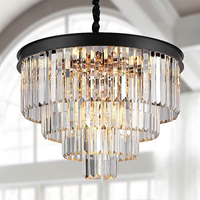
Modern Crystal Chandelier from Amazon
This black chandelier is ideal for the dining room, living room, bedroom, foyer, kitchen, or even staircase. The piece contains K9 crystals and is made of a high-quality handmade metal frame.
2. Consider rosy tones of pink

'Dining room colors at their best in my opinion set the stage for laughter, connection, and or romance,' says Jennifer Morris, founder of JMorris. 'So colors that flatter the skin tone or feel comfortable and rich will be a good backdrop. I find warm rosy colors amazing for dining. When you paint pink, the wall color reflects beautifully off the skin so everyone looks healthier.'
Pink is a refreshing, happy, and bright hue, just a color that adds a little cheer to your place. When it comes to the best pink paints, there are several to choose from – from pales, darks, sandy, dusty, cotton candy, to luscious pinks.
Pink is always having a moment. Interestingly, it is also a hue that calms the mind. In 1979, Alexander Schauss, a renowned psychologist published a research on the effects of this hue. Pink was used in US prisons for decades, which helped make the inmates less aggressive. It was also used with similar effects in a youth detention center in San Bernardino.
Consider injecting this color through dining room wallpaper, furniture, or even accessories. This shade goes particularly well with wood tones and fills a space with personality.
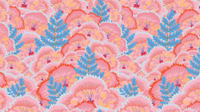
Electric Poppies 01 from Lick
This wallpaper with blooming pink and blue botanicals is the ideal addition to a modern home. Designed by Studio Coverdale, Electric Poppies 01 is about 'fun and frivolity'.
3. Create depth with teal

Sure, a deep tone like teal may seem like a bold choice for dining room color ideas but deep, dark colors can have several benefits; both aesthetic and illusionary.
A tone that is a mix of green and blue, teal is a dark cyan with an imposing presence. It evokes visuals of tropical lagoons, dense jungles, and beautiful dancing peacocks. For starters, it works well with natural fibers and neutral colors, as well as with lighter blues.
Deep colors tend to give a space a sense of depth, and a feeling of endlessness. If you have a small dining, consider painting it teal. Dark colors also make a room recede, which means, if you have exceptionally high ceilings, and want the room to be cozier, choose to paint this hue on the ceiling.
'A dining room is a perfect place to make bold design choices and pick a color you might not usually try,' says Chelsea Clark, head of brand at Lust Home. 'As a room generally dedicated to hosting, creating an inviting ambiance is often top of the list. To create a more ambient and dramatic feel, choose a dark jewel tone or rich hues, to create a timeless and sophisticated backdrop, perfect for entertaining.'
'If you are looking to create a more traditional look then another popular route is to bring deep colors of teal into the dining room with layers of pattern and color on the walls and soft furnishings to create a cocooning effect which can be enhanced with clever lighting and the use of candles,' says Amanda.
4. Add a cheerful touch with orange

That beautiful blend of yellow and red, orange in its truest form, is an equal mix of the two. However, the color can range from almost red to bright tangerine and reminds one of the sunsets and tropical fruits, and it is undeniably cheery and bold.
'The best dining room paint colors are yellows and oranges,' says interior designer Natalie Tredgett, founder of Natalie Tredgett Design. 'The hues are energetic and warm. They encourage conversation, comfort and happiness. These colors are lovely during the day as well as at night.'
As per research, orange is said to stimulate activity, appetite, and socialization, and in terms of decor, it works wonderfully well with more muted background colors. It pairs well with blue, turquoise, as well as grey. In its more subdued form, it can blend into brown.
5. Go for blue for a timeless look

'I chose Anchors Away by Sherwin Williams for a deep bold color that would not only act as the focal point for the room but also compliment the white walls above,' says Ginger Curtis, founder of Urbanology Designs .'In addition, it really compliments the wood tone colors as well.
'If you’re looking to make a dining room feel bigger, a lighter color can help to make the space feel airy and open,' says Chelsea. 'Known for their calming effects, blue is a great option for a dining room.'
While talking about colors, if you want to try something new and different, consider interesting paint techniques that could give your dining room a special effect. Try half-painted walls, as seen in this image.
This is especially useful if you don't have an interesting architectural detail in your home. A half-painted wall can help you 'fake' one. A great alternative to wall paneling, it can divide the room into two halves. Also, you could choose to paint only a third, or even two-thirds of the wall in a different hue, creating an entirely different effect.
A great color for the dining space, blue goes well with several other hues, opening up the opportunity for more pairings and layering.
6. Green will remind you of the outdoors

We say, squeeze a little lime into the space where you dine! Think green walls, chairs, accessories, and lights...all can make a delicious escape.
'Green is a great choice for dining rooms with a garden view and the natural hue will bring a fresh but calm feel to the space,' says John Ashton of Albany.
Green goes with several colors and is available in many undertones, so you truly are spoilt for choice. For a softer, sophisticated vibe, consider a cooler bluish green. Think celery-green wall color and watery blue-green floor-to-ceiling curtains. The palette has a soothing effect and can encourage guests and dwellers to spend long hours here.
Chartreuse, mixed with white and wood can create the perfect outdoor vibe. If it's too bold for you, consider the color for an accent wall. A combination of green and yellow can also be a great, fetching palette with nice softness to it. Sunny yellow-green is a happy color that brings warm summer days to mind.
7. To make a statement, choose red

Did you know that red can stimulate our appetites and even our conversations? But understandably, a fully red room can seem too intense for most of us. So, how do you get red right? You could consider bringing it in as an accent color, with a swath on a wall, ceiling, or floor.
A large, red dining room lighting piece like a chandelier or a pendant could also work. Otherwise, consider red chairs around a wooden dining table or a red carpet.
'If you love a bright color think about trying it one or two levels lower on the color chart for a soft feel,' says Jennifer.' I would also say wall sconces, table lights on dimmers, and candle lights will go a long way to creating a soft feel.'
Red, being a warm hue pairs with rich wood tones and other warm, neutral hues. A room enveloped in, say a terracotta shade can give a cozy, traditional feel to a space.
8. Keep things subtle with grey

Medium to dark grey dining rooms have an air of sophistication. This hue can be warmed up by incorporating wood tones or other warm neutrals. Grey pairs well with several colors and doubles as the perfect backdrop for light-colored artwork or decorative accessories.
Due to its light visuals, consider color drenching this hue to create a cocooning feeling inside your dining room.
'If you have grey or neutral walls and flooring in the dining room, which most people do tend to have, then bringing furniture pieces in natural woods, linens and stone will add a tactile edge to space whilst connecting you back to nature,' says Amanda. 'Keeping it tonal in muted, earth tones will keep the look cohesive whilst monochrome accents will help add interest and eye-catching detail. Accessories in metallics will add an understated glamor and bring warmth to the overall look.'
What colors should you not use in a dining room?
The dining room should be a calm, relaxing space; one where you would happily spend time in, hosting friends or having long, indulgent meals with family. For this reason, when designing the dining room, choose hues that are warm, tranquil, and do not create a glare.
Stay away from stark white that has a clinical feel to it, making it uncomfortable to sit around in. Also, do not go overboard with color. Often, a good, convivial dining room is best grounded in warm neutrals such as beige, brown, or yellow. But overlaying too many tones, on walls, floor, upholstery, and accessories can hinder the sophisticated look you’re aiming for, and also create confusing energy in the space.
Keep the palette limited to two or three colors, and create a space that is a mini jewel box in the house.
Be The First To Know
The Livingetc newsletter is your shortcut to the now and the next in home design. Subscribe today to receive a stunning free 200-page book of the best homes from around the world.
Aditi Sharma Maheshwari is an architecture and design journalist with over 10 years of experience. She's worked at some of the leading media houses in India such as Elle Decor, Houzz and Architectural Digest (Condé Nast). Till recently, she was a freelance writer for publications such as Architectural Digest US, House Beautiful, Stir World, Beautiful Homes India among others. In her spare time, she volunteers at animal shelters and other rescue organizations.
-
 5 Habits to Adopt That Will Make Your Home Smell Good All the Time — 'Add Them to Your Routine Today!'
5 Habits to Adopt That Will Make Your Home Smell Good All the Time — 'Add Them to Your Routine Today!'Incorporating these tricks into your maintenance routine will keep every corner of your home smelling fresh and welcoming
By Katie Baxter Published
-
 7 Ways Expert Organizers Reduce Visual Clutter in the Kitchen — 'They're Virtually Effortless!'
7 Ways Expert Organizers Reduce Visual Clutter in the Kitchen — 'They're Virtually Effortless!'Follow these expert tips to reduce the cluttered look in your kitchen and create a visually harmonious space perfect for hosting
By Imogen Williams Published
